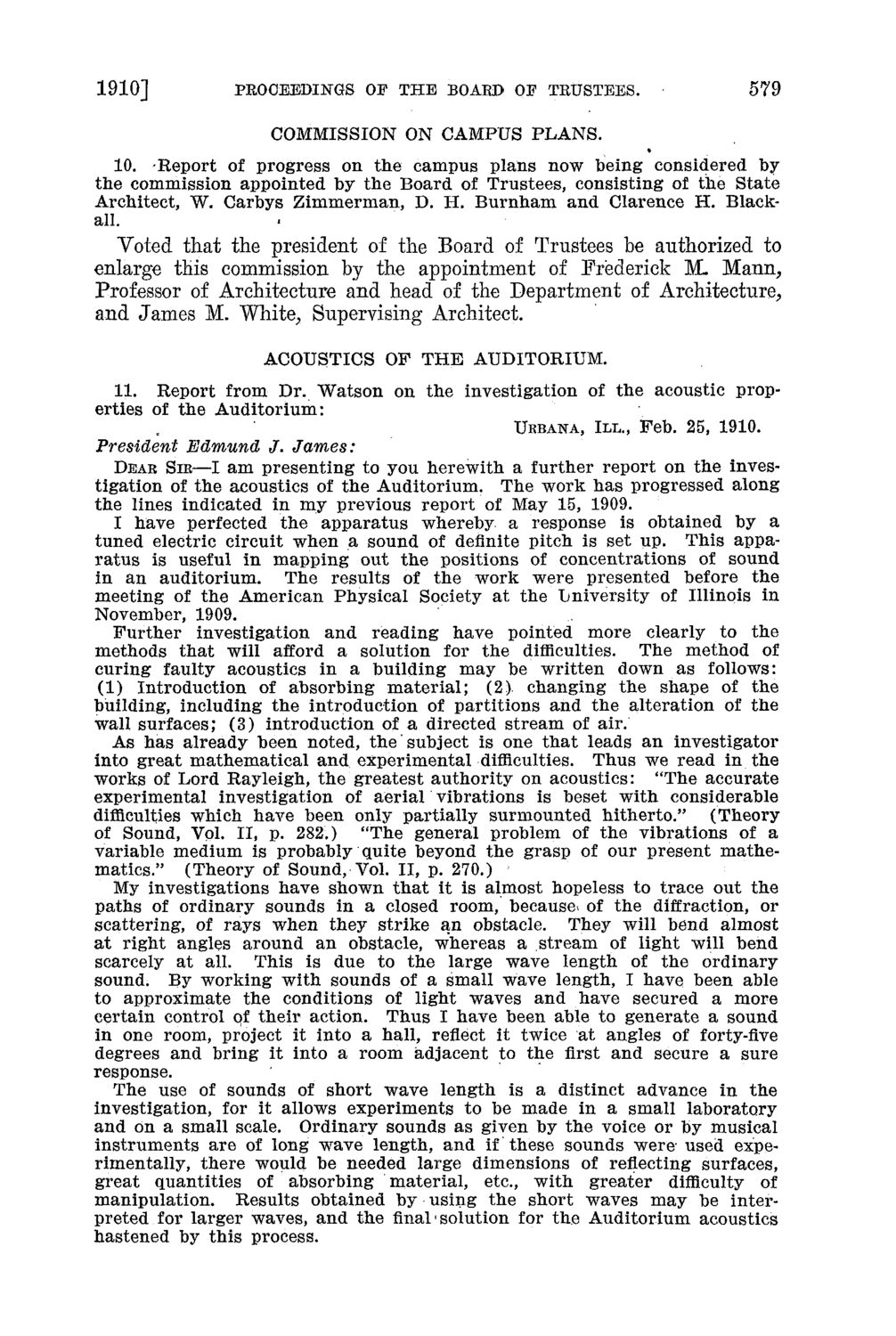| |
| |
Caption: Board of Trustees Minutes - 1910
This is a reduced-resolution page image for fast online browsing.

EXTRACTED TEXT FROM PAGE:
1910] PROCEEDINGS OF THE BOARD OF TRUSTEES. COMMISSION ON CAMPUS PLANS. 579 10. Report of progress on the campus plans now being considered by the commission appointed by the Board of Trustees, consisting of the State Architect, W. Carbys Zimmerman, D. H. Burnham and Clarence H. Blackall. Voted that the president of the Board of Trustees be authorized to enlarge this commission by the appointment of Frederick M. Mann, Professor of Architecture and head of the Department of Architecture, and James M. White, Supervising Architect. ACOUSTICS OF THE AUDITORIUM. 11. Report from Dr. Watson on the investigation of the acoustic properties of the Auditorium: URBANA, I I I . , Feb. 25, 1910. President Edmund J. James: DEAR SIR—I am presenting to you herewith a further report on the investigation of the acoustics of the Auditorium. The work has progressed along the lines indicated in my previous report of May 15, 1909. I have perfected the apparatus whereby a response is obtained by a tuned electric circuit when a sound of definite pitch is set up. This apparatus is useful in mapping out the positions of concentrations of sound in an auditorium. The results of the work were presented before the meeting of the American Physical Society at the Lniversity of Illinois in November, 1909. Further investigation and reading have pointed more clearly to the methods that will afford a solution for the difficulties. The method of curing faulty acoustics in a building may be written down as follows: (1) Introduction of absorbing material; (2) changing the shape of the building, including the introduction of partitions and the alteration of the wall surfaces; (3) introduction of a directed stream of air. As has already been noted, the subject is one that leads an investigator into great mathematical and experimental difficulties. Thus we read in the works of Lord Rayleigh, the greatest authority on acoustics: "The accurate experimental investigation of aerial vibrations is beset with considerable difficulties which have been only partially surmounted hitherto." (Theory of Sound, Vol. II, p. 282.) "The general problem of the vibrations of a variable medium is probably quite beyond the grasp of our present mathematics." (Theory of Sound, Vol. II, p. 270.) My investigations have shown that it is almost hopeless to trace out the paths of ordinary sounds in a closed room, because* of the diffraction, or scattering, of rays when they strike an obstacle. They will bend almost at right angles around an obstacle, whereas a stream of light will bend scarcely at all. This is due to the large wave length of the ordinary sound. By working with sounds of a small wave length, I have been able to approximate the conditions of light waves and have secured a more certain control of their action. Thus I have been able to generate a sound in one room, project it into a hall, reflect it twice at angles of forty-five degrees and bring it into a room adjacent to the first and secure a sure response. The use of sounds of short wave length is a distinct advance in the investigation, for it allows experiments to be made in a small laboratory and on a small scale. Ordinary sounds as given by the voice or by musical instruments are of long wave length, and if these sounds were used experimentally, there would be needed large dimensions of reflecting surfaces, great quantities of absorbing material, etc., with greater difficulty of manipulation. Results obtained by using the short waves may be interpreted for larger waves, and the final • solution for the Auditorium acoustics hastened by this process.
| |